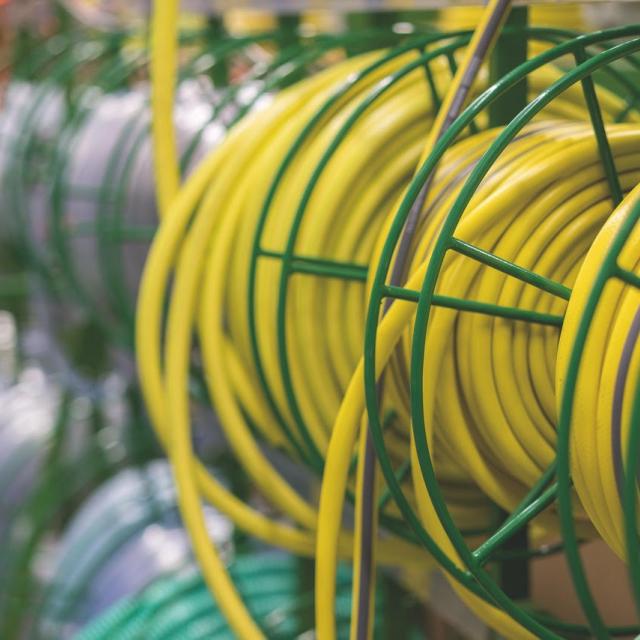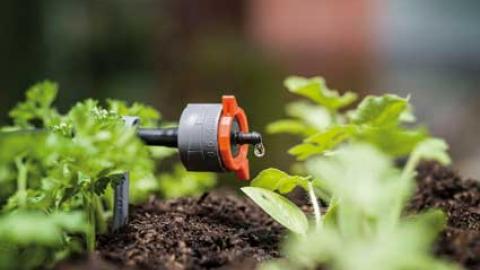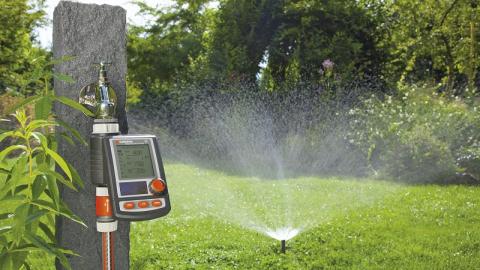The hose reel and hose pipe are essential for the garden, but when trying to choose between a single-layer hose, or multi-layer, or a rubber hose or a micro-perforated soaker hose or a reinforced one, it can become confusing. In dimensions of 15 or 19 mm with or without a reel, on a wall-mounted hose reel: follow our advice to achieve an excellent level of irrigation.

Important features
• Number of layers
• Knitted or woven reinforcement
• Braided/wrapped
• Expandable
• Non-twist
• Microporous
Influence of the number of layers on the quality of the hose pipe
When we talk about quality, we are talking about the resistance of the hose pipe; that primarily refers to the number of layers. The layer is, therefore, directly related to the quality of the product and its degree of rigidity.
Nowadays we have multilayer hoses. A 3-layer hose is considered as being a product at the low end of the range. A 4-6 layer hose is the one that is less accident-prone and more resistant to friction wear (abrasion), bending, knots and tangles and pinching or crushing, but it is also resilient to climate hazards such as UV rays and temperature variations.
When the pipes have reinforcements, this helps to prevent kinking and twisting, which can adversely affect the laying out of the hose.
The main types of hose pipes for watering the garden
Drip tube. The drip tube allows for the irrigation water to be applied directly to the base of the flower beds and other shrubs since it has multiple connections (to be laid out as required by yourself). Often made of PVC, it is economical because drip irrigation uses drippers.
Woven or knitted reinforced hose pipes. The woven or knitted reinforced hose pipe is the one that has the famous 4-6 layers. It has a component in its mesh or lattice which stops it kinking, thus making it more resistant.
Braided Pipe. This pipe often has 3 layers. It is resistant because the core of the hose has a fine wire mesh. It does not kink and is more resistant to the water pressure.
Expandable hose pipe. The expandable hose pipe is short in length, of small diameter and useful for irrigating in proximity or for common cleaning operations. It is often sold with its connections and its spray nozzle and/or spray gun.
Non-twist hose pipe. With the non-twist hose pipe, you are going to have a hi-tech hose. It is thus resistant to extremes of temperature and UV rays; it is flexible, non-twisting and very easy to handle. It is the ultimate in irrigation hoses!
Microporous hose. The microporous (soaker) hose is even more useful when you want to irrigate on open ground in a long and well-dispersed manner for the crops. The tube does not spray the crops but rather it irrigates by releasing water through the micropores.
Practical guide to determining the diameter of the hose pipe
The concern of having a hose that is too short means that we tend to go for pipes that are quite long to make them easier to use and save on time-consuming handling operations.
However, a 50 m. pipe with a 19 mm diameter is very heavy and not easily handled… in other words, with this kind of product it would be better to acquire a new irrigation accessory: the hose reel.
Let’s return to the diameter, though! Put simply, a hose pipe of less than 50 m. in length will have a diameter of 15 mm.
This diameter is ideal for small irrigation surfaces and cleaning work such as washing the car, garden furniture, the terrace, etc. One of the laws of hydraulics states that the smaller the pipe diameter, the higher the pressure at the end of the line.
Hose pipes with a diameter of 13 or 15 mm easily support pressures of 2 to 5 bar.
However, for longer pipes it is essential to have a diameter of 19 mm. This applies in particular when there are several connections required. You will have less pressure but a higher flow rate. And once again, think about your back. The larger the diameter, the heavier the pipe will be, so perhaps you should get a hose reel!
For fixed irrigation installations, where the pipe supplies a sprinkler, it could be possible to use a lower quality product (a 3-layer hose pipe could be sufficient) because it does not have to be moved daily.
Choosing the right garden hose reel
In French, the terms enrouleur (hose reel) and dévidoir (hose feeder or uncoiling device) are both used. This item is essential for the ease-of-use and convenience of the hose pipe.
Wall-mounted hose reel. The wall-mounted hose reel is attached to the wall with a bracket, plugs and a screws and installed near a water source. It can be monodirectional (in a fixed direction) or swiveling (multidirectional, it swivels from left to right).
Automatic hose reel. The automatic hose reel is ideal for those who don’t have a lot of time to spare and for ease of use. Different pipe lengths are available and the quality of the hose reel and the pipes depends on the models.
You already know about the hose pipes; for the hose reels, appraise the materials and whatever they have to say about them because a well-known brand will offer better quality.
Quite often you will find, within the range, hose reels supplied with a 15/20 m. hose pipe and an assembly of irrigation accessories including a spray nozzle and a spray gun.
Models that are not supplied with a hose and made of different materials (steel or plastic) can accommodate greater lengths and diameters. Give preference to rigid and stable structures for 50 m. 6-layer hose pipes.
Here are some tips for maintaining the garden hose
The enemy of the irrigation pipes during fine weather, whatever the model, is the sun. So avoid leaving it lying around in the garden in direct sunlight during the height of summer.
Also don’t forget to drain the water from the tube each time it is used to prevent stagnant water accumulating inside the hoses.
Make sure you wind in properly. Your hose pipe will have a longer working life if it is not left kinked and twisted for many months.
Needless to say, when winter arrives the hoses and pipe connections have to be drained and emptied of all the water and stored in the warmth of the garage or garden shed.


